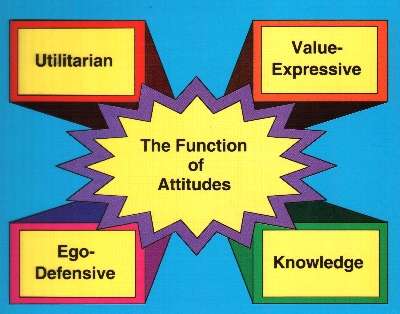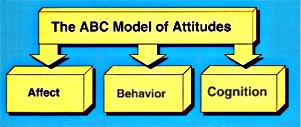 |
Exercise
Attitude |
We'll
look for examples of ads based in these theories in magazines
(I'll bring some or you can use one you bring
yourself) |
|
THE POWER OF ATTITUDES
Functions of
Attitudes
Utilitarian
Does it give you pleasure or pain? Do you like it
or hate it? |
 |
Value-Expressive
What does the product say about you?
|
|
Ego-Defensive
What self-doubts does it help you overcome?
|
Knowledge
Does the product meet your needs for order and
structure?
|
ABC Model of
Attitudes & Hierarchies of Effects
 |
Affect – how you feel about the product
Behaviour –
how you respond
Cognition – what you believe about the product
|
Depending on the level of Involvement
High Involvement
Learn-Feel-Do
(based on cognitive information processing) |
 |
Low Involvement
Learn-Do-Feel
(based on behavioural learning processes) |
 |
Experiential
(Zajonc's Model)
Feel-Do-Learn
(based on hedonic consumption) |
 |
These are just models of what
we think is typical average behaviour; you may well have
purchased a car as a high involvement hierarchy or you may
find that brand of frozen peas is high-involvement for you.
The point is that we start with a model that suggests a
typical behaviour, knowing that no person is
"typical" or "normal." It's
More Than Just Your Attitude Toward the Product
Attitude
toward the Act of Buying in General
believe it or not, some people just don't like to
go shopping (your professor is not among these)
Attitude toward the Ad for the Product
Think of a product you buy just because you like
the ad... or don't buy because you don't like the ad Feelings
Aroused By Ads
 |
Exercise
Feelings About Ads |
Find an
example of one ad for each of these kinds of feelings;
that is - an ad that arouses in you upbeat feelings, one
that arouses warm feelings, and one that arouses
negative feelings. Be prepared to discuss why you think
you react this way to these ads |
|
FORMING ATTITUDES
Levels
of Commitment to Attitude
|
Compliance |
|
Identification |
| Internalization
|
 |
Exercise
Levels of Commitment |
Think of one product from your personal experience about
which you have each of these three kinds of commitment.
What do you buy just to comply, perhaps with your need to
fulfill something? What do you buy because you identify
with the brand? What do you buy because "it's
you"? |
|
Consistency
Principle
| Cognitive
Dissonance Theory |
|
Self-Perception Theory |
ATTITUDE MODELS
Multi-Attribute Attitude
Models - Fishbein
|
ORIGINAL FISHBEIN
Aijk = SBijkIik
salient beliefs
object-attribute linkages
evaluation
|
|
EXTENDED FISHBEIN
B~BI = W1Ab +W2(SN)
where:
B = behaviour
~ means “approximates”
BI = intention to behave
W = weights of importance
Ab = attitude toward behaviour
SN= social norms - who cares?
|
USING ATTITUDES TO
PREDICT BEHAVIOUR
Problems with
using Extended Fishbein (Reasoned Action) Model to Predict
Behaviour
|
Model deals with actual
behaviour, not outcomes of behaviour
|
|
Some things are beyond consumer's control
|
|
Behaviour is not always intentional |
|
A measure of Attitude is not always equal to Behaviour
|
|
Works better in a shorter time frame
|
|
Attitude Accessibility: Direct experience yields a
stronger measure of attitude
|
Note too that the Extended Fishbein model only addresses North American
culture
Time for Group Meetings
|